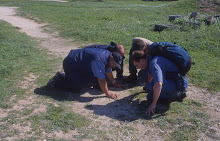It is all too easy to say that statistics is the art of lying and that you can demonstrate everything by simply changing a parameter. You can actually change evrything bu cahnging a parameter, but that is true also if you change the method of staining of a preparate under a microscope. The problem is that biologists (an psychologists and physicians) think that statistics is a sort of artificial intelligence, not different from the supercomputer in The Hitchhiker's Guide to the Galaxy; where you enter the data and get the answer. Science is not that easy and if such a computer will ever be build it will anwser "42". Statistics is a tool, exactly like a microscope. If your put the wing of a fly under the microscope you will get a very different picture than if you put a leg - and that is exactly what you do when you change a parameter. The fact that most ecologists do not appreciate this is because they often cannot tell a wing from a leg: they download huge amounts of data from repositories and play with models without knowing much about the data - they often put under the microscope the lef of a fly thinking it is a wing.
Another problem is that statistics is expressed in formula, so that many mistake statistics for mathematics, which statistics is not. Mathematics is a language, statistics is again a tool. A language is a set of rules that allow to relate thing (often in very complex ways) and thus extends our midn, whereas a tool is something that extends our senses, like the microscope or the telescope. Fundamentally statistics is a tool that allows to "see" the randomness and noise in data, which is something that our brain has much difficult to appreciate. The simple regression model is for instance Y = a*X +error;; the difference between a statistic tool and a mathematical relation is just in the last tarm.
Iscriviti a:
Commenti sul post (Atom)

Nessun commento:
Posta un commento